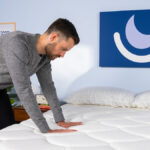Post-traumatic stress disorder (PTSD) is a common condition that may occur after someone experiences trauma. Sleep problems, such as insomnia and nightmares, are well-established symptoms of PTSD and are even part of its diagnostic criteria. People with PTSD are also more likely to have sleep apnea, a disorder involving repeated breathing lapses during sleep.
We cover how PTSD and sleep apnea are linked, how this can be an issue of special importance to veterans, and how treatment can improve PTSD and sleep apnea.
Understanding Sleep Apnea and PTSD
Sleep apnea and PTSD are distinct health conditions, but studies have found a correlation between them. While some experts believe that the conditions have related underlying causes, more research is needed to better understand the connection between sleep apnea and PTSD.
Sleep apnea is a condition in which someone has recurring pauses or reductions in breathing during sleep. The most common type of sleep apnea, obstructive sleep apnea (OSA), affects between 10% and 30% of U.S. adults. Untreated sleep apnea can lead to poor sleep quality, daytime sleepiness, and other health issues.
PTSD is a disorder that arises in response to experiencing a traumatic event. PTSD can be caused by different types of intense traumas, including physical abuse, natural disasters, car crashes, and war. Disturbing experiences in training or combat can make military veterans more likely to have PTSD than civilians.
People with PTSD experience a range of symptoms. Those with PTSD will often relive a traumatic event in flashbacks or nightmares, and they may go out of their way to avoid reminders of their trauma. They may be in a constant state of alert and frequently have negative thoughts or moods.
PTSD and Sleep Quality
Sleep disturbances are a major problem for many people with PTSD, with nightmares and insomnia being common symptoms of the condition. Other sleep issues, including sleep apnea and fragmented sleep, are also linked to PTSD.
Sleep problems and PTSD can interact to create a vicious cycle. PTSD may make it hard to get good sleep, and in turn sleep disturbances and sleep loss can heighten anxiety and aggravate PTSD symptoms.
Can PTSD Cause Sleep Apnea?
Research has found that people who have PTSD are more likely to also have obstructive sleep apnea. However, this does not mean that one condition causes the other. Some experts suspect that changes in certain areas of the brain are involved with both OSA and PTSD, but more research will be necessary to clarify the relationship between PTSD and sleep apnea.
Another connection between PTSD and OSA is that there is overlap in the factors that can affect the risk of developing the conditions. For instance, both PTSD and OSA occur at higher rates in people who have had problems with substance abuse or mental health conditions like mood or anxiety disorders.
The Link Between PTSD and REM Sleep
Research has found that people with PTSD are more likely to experience disturbances of rapid eye movement (REM) sleep, which is the stage of sleep when most dreams occur. People with PTSD are more prone to awaken from REM sleep feeling anxious and may spend less time overall in REM sleep. This can lead to reduced sleep quality and worsening of PTSD symptoms.
A sleep disorder called REM sleep behavior disorder (RBD) occurs more frequently in people with PTSD. The symptoms of RBD include physically acting out dreams during REM sleep, which sometimes involves significant or even violent movements of the arms and legs.
Normally, REM sleep is part of the process that helps individuals emotionally process trauma and understand that it no longer poses an immediate threat..The fragmentation of REM sleep experienced by people with PTSD may interfere with the processing of difficult memories, which can fuel a challenging cycle of worsening sleep and PTSD symptoms.
How to Treat Sleep Apnea and PTSD
Both sleep apnea and PTSD are conditions that often get better with treatment. Various treatment options are available, and it may be necessary to try multiple approaches to find what is most effective.
Several kinds of treatment may help address the symptoms of PTSD:
- Therapy: Experts often recommend trauma-focused therapy as an initial treatment for PTSD. Working with a psychologist, social worker, or counselor can help reduce sensitivity to trauma triggers and develop techniques to apply during flashbacks and other challenging situations.
- Medication: Different kinds of prescription drugs may be prescribed to try to address a person’s most bothersome symptoms. For example, drugs may be prescribed to improve mood or reduce nightmares.
- Emotional support: Many people with PTSD benefit from support groups and other opportunities to to speak with other people who have experienced similar challenges. In addition to support from other people, self-help may be available through mobile apps and other tools that can be suggested by a therapist.
Treating sleep disturbances, including sleep apnea, can improve symptoms associated with PTSD. Several common treatments for OSA may be prescribed following a diagnosis from an in-lab or at-home sleep study.
- Behavior change: People with OSA can take steps to reduce its severity by avoiding alcohol, changing their sleep position to avoid sleeping on their back, and engaging in regular exercise.
- Positive airway pressure therapy: Most people with OSA experience a reduction in their symptoms with positive airway pressure (PAP) therapy, such as with a CPAP or APAP machine. These devices help prevent breathing disruptions during sleep. People who have both PTSD and OSA often have fewer nightmares and other PTSD symptoms when they consistently use a PAP machine.
- Surgery: In some cases, surgery to modify the anatomy around the upper airway may be a treatment for OSA. Another type of operation can implant a nerve stimulation device that activates specific muscles during sleep to help maintain steady breathing.
Sleep Apnea Secondary to PTSD Rating
The Veterans Administration (VA) assigns disabled veterans a disability rating based on how their condition affects their health and daily life. A veteran’s disability rating is used to help determine the amount of compensation and benefits they receive. Veterans may also be entitled to benefits for health conditions that are directly linked to their military service.
The VA acknowledges that sleep apnea and PTSD are often found together, so the VA may provide benefits for OSA linked to service-related PTSD. Any veteran who has questions about their disability rating and available benefits related to PTSD or sleep apnea should contact their doctor or the VA for more detailed information.
When to Speak to Your Doctor
Both PTSD and OSA can be improved with treatment, which can help keep the conditions from worsening or leading to other complications. For this reason, it is important to talk with your doctor if you have symptoms that could be related to PTSD or sleep apnea.
Some of the most common symptoms of PTSD include:
- Unwanted memories of a trauma
- Frequent nightmares or other sleep problems
- Avoidance of thoughts, activities, or people that are reminders of a traumatic event
- Depression, irritability, aggressive behavior, or other mood changes
- Nervousness or constantly feeling on alert
Potential symptoms of OSA that should be discussed with a health care provider include:
- Excessive daytime sleepiness
- Gasping or choking during sleep
- Loud snoring
- Trouble staying asleep
- Morning headaches
It may be helpful to begin the conversation by talking to your primary care provider who can review your symptoms and, if necessary, refer you to a psychologist, counselor, social worker, or sleep specialist for further evaluation.
References
Ask the Sleep Doctor
Have questions about sleep? Submit them here! We use your questions to help us decide topics for articles, videos, and newsletters. We try to answer as many questions as possible. You can also send us an email. Please note, we cannot provide specific medical advice, and always recommend you contact your doctor for any medical matters.


